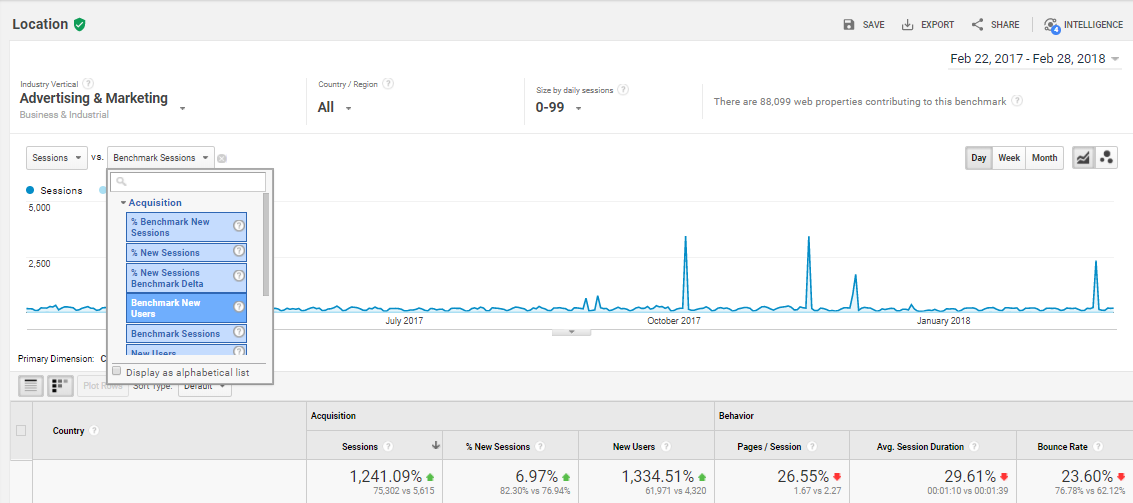Benchmarking with Google Analytics
Understanding the composition of your landscape depends on knowing what’s is common around you. In Google Analytics you can review a benchmarking report that lets you compare your traffic levels to those of other sites with similar traffic volumes in your industry.
In your account, navigate to Reports and choose Reports > Audience > Benchmarking. There you can choose from Channels, Location, Devices and Users Flow.
Changing the location, session range or benchmark sessions can help illuminate where you fit in among those in your space across various KPIs. Higher than average returning users in a particular place may signify that you’ve really struck a chord with users there. This can lead to a deeper investigation of what’s going right, so that knowledge can be applied elsewhere.
These types of insights provide a valuable understanding of what is standard, what qualifies as above average or when your performance is lagging behind.
Tip: It’s also useful to put a face on the competition aside from anonymous, general industry data. That’s a smart idea. But keep a diverse list, be sure to not focus too much on one competitor, no matter how strong. Have at least a few other viable competitors that you can use to broaden your context and better frame success.
It gets you out of your own bubble
Getting out of your own’s organization’s bubble is important. For starters, no organization is immune to groupthink. The most self-aware of organizations might have better mechanisms to combat it, but they come with increased investment in those very mechanisms. And this is where marketing has this tense dual mandate. Be creative, but be efficient. Show vision, but above all, show ROI. And so out of necessity, we process. We workflow. And sometimes, we compromise. And these unique choices are our own, but they are a small sample size indeed. We sometimes have no idea how our competitors would tackle the same challenges, critical to mundane.
Marketers by and large have a very little luxury to play Edison - succeeding through failure. We get a very small failure budget and we are miserly in expending it. If you want to grow your data set, you have to get out of your own bubble. If you want to avoid groupthink, you have to get out of your own bubble. And if you want to learn from failure without enduring failure, you have to get out of your own bubble. Competitive research can show you different takes on the newest of problems and it can reveal strange new doors and possibilities in the most familiar.
Tip: Foster a competitive intelligence culture in your organization, at least within marketing. And this doesn’t have to be just more dry meetings to get lost in the calendar. Provide some resources and set up a minimal structure, but try to make it fun. A contest leaderboard, a “tip” line Slack channel, a periodic competitor roast or effigy: all are creative ways to get multiple people engaged and keeping an eye on the competition.
It saves time and money on other research
As mentioned previously, research is an investment. Some investments show ROI not through appreciation or growth, but simply by saving you time and effort. As organizations expand marketing efforts into new channels and initiatives, where there is a documented roadmap for success, due diligence demands you look at it and save time by learning lessons now rather than later.
In SEO, if you want to acquire quality backlinks to your website, first find your competitors’ best links and then learn what pieces of content got them . If you want to know what ad groups are a good start, you should find a competitor who’s killing it in AdWords, see what they are bidding on and then snoop around on their landing pages.
In social media, PR, email, all of it: find out who’s doing it right and what your organization can take away from that and how you could make it your own. No matter how innovative you may be there’s always an opportunity to gain inspiration from your competitors.
Tip: Tools are your friend! So many inbound marketing solutions have competitor intelligence features and dashboards. You don’t need to hand gather every last piece of intelligence and automation can turn time spent data gathering into time spent analyzing.
Competition is fluid
The marketing world moves quickly and frequent is as relative a term. So is competition. Just like your audiences and customers understanding your competitors in segments is crucial. It’s never safe to assume a top organic search competitor is equally completive in paid advertising. Within broad channels like social media, dive deeper: competitors finding success on LinkedIn are going to have a much different blueprint than those thriving on Instagram. Keep on top of who’s doing what in these channels.
There may be newcomers in your space at any time. A long-standing rival in one channel may be struggling in another leaving you an opening to capitalize on their missed opportunity. A competitor may be releasing a new site design or quietly adding a major infusion to their AdWords budget at any time the shape of your completion can change anytime. So it competitive research is a semi-annual investment of time, important changes can be missed.
Tip: Set different types of competitor intelligence checks for different periods of time to maximize time and insights. Following the daily social media streams of your competitors will be more meaningful than checking their keyword rankings every day. You only want or need real-time snooping when you have the agility to make meaning of any sudden changes or opportunities and the ability to execute on them. Otherwise, tie the interval durations of these checks and analysis to a more appropriate pace.
Conclusion
Researching competitors is probably an active part of your digital strategy. But is it a featured component? For some, competitor research may be a semi-annual or even less frequent luxury of time. For others, it may be an unhealthy fixation on one rival. Neither of these scenarios is ideal. The right balance integrates regular and productive competitor analysis into an ongoing process. The strongest marketing strategies are those that are informed, not just by their own data, but by knowing how their numbers stack up in the big picture.



